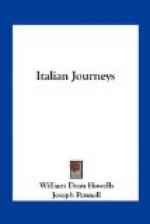I assure the reader that I made none of these apt reflections in the Campo Santo at Pisa, but have written them out this morning in Cambridge because there happens to be an east wind blowing. No one could have been sad in the company of our cheerful and patient cicerone, who, although visibly anxious to get his fourteen-thousandth American family away, still would not go till he had shown us that monument to a dead enmity which hangs in the Campo Santo. This is the mighty chain which the Pisans, in their old wars with the Genoese, once stretched across the mouth of their harbor to prevent the entrance of the hostile galleys. The Genoese with no great trouble carried the chain away, and kept it ever afterward till 1860, when Pisa was united to the kingdom of Italy. Then the trophy was restored to the Pisans, and with public rejoicings placed in the Campo Santo, an emblem of reconciliation and perpetual amity between ancient foes. [I read in Mr. Norton’s Notes of Travel and Study in Italy, that he saw in the Campo Santo, as long ago as 1856, “the chains that marked the servitude of Pisa, now restored by Florence,” and it is of course possible that our cicerone may have employed one of those chains for the different historical purpose I have mentioned. It would be a thousand pities, I think, if a monument of that sort should be limited to the commemoration of one fact only.] It is not a very good world,—e pur si muove.




